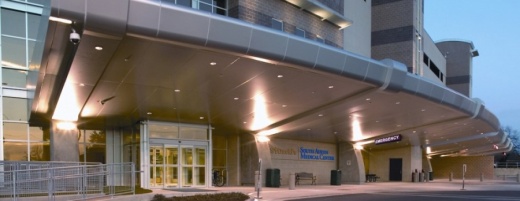In a matter of one week, the rolling seven-day average for new coronavirus hospital admissions nearly doubled, jumping from 12.8 new admissions June 7 to 20.6 new admissions June 14.
As of June 21, Austin and Travis County reported 25.7 new coronavirus hospitalizations over a seven-day average.
As the case information was being reported, Austin Mayor Steve Adler and Mark Escott, Austin-Travis County interim medical director and health authority, sounded the alarm to the public that should new hospitalizations continue to climb, the area’s hospital systems are at risk of becoming overwhelmed.
“We’re not saying the hospitals are overwhelmed now. In fact, there is plenty of capacity. The concern is what’s going to happen three or four or five weeks from now,” Escott said during a June 17 news conference. “We can't wait until the hospitals are full before we take action.”
Adler said the city has plans in place to erect field hospitals and house patients in the city’s convention center if the area’s hospital systems do become overwhelmed. However, Adler warned these treatment centers would be less than ideal to treat that many COVID-19 patients.
“While we’ll have beds, they’re not the same kind of beds. People in those facilities don’t get the same kind of care,” Adler said June 11.
At Austin’s major medical centers, hospital officials say they have had appropriate time to prepare their hospital systems for this moment. In the months since Austin’s first confirmed case of the coronavirus, hospital executives say they have had time to secure equipment, train health care staff and study effective coronavirus care from other health care institutions across the county.
“We have more than adequate numbers of ventilators and large stockpiles of personal protective equipment,” said Dr. DeVry Anderson, chief medical officer at St. David HealthCare's South Austin Medical Center. “In the early phases of COVID-19 we took a lot of steps to make sure ... we have those things on hand.”
Anderson told Community Impact Newspaper that St. David's South Austin Medical Center has opened treatment wards and transitioned nurses in its system to prepare for any potential surges in coronavirus hospitalizations. Over the past week, Anderson continued, the medical center has taken steps to create adequate space on its floors for COVID-19 patients.
Some of these preparations have been months in the making. In early April, St. David’s temporarily closed some of its regional medical centers to reallocate personnel and other resources within its system.
The area’s hospitals over the past several months have also established a series of protocols for incoming patients to prevent the spread of the coronavirus throughout the hospital system.
According to Baylor Scott & White, the hospital system has begun testing patients for coronavirus through drive-up locations and has amended the infrastructure of its medical centers to keep patients out of common areas, such as waiting rooms, for as long as possible.
“We want patients to have confidence that their safety is our top priority and to feel peace of mind when scheduling and receiving care,” said Dr. Rob Watson, chief medical officer of the Austin and Round Rock region for Baylor Scott & White Health, in an email to Community Impact Newspaper.
Through virtual waiting rooms at Baylor Scott & White hospitals, patients receive calls or text messages from the hospital with updates, minimizing the time patients ultimately spend inside the hospital’s walls.
Anderson said St. David’s is similarly testing patients through drive-up clinics. All patients checking into the hospital are pretested for coronavirus, Anderson added. Further, patients coming to the emergency room are mandated to wear masks and gloves while they wait for care.
Vital communication between local leaders and even between hospital systems has also been established to improve the response to any surge of coronavirus cases. According to Anderson, hospital leaders have daily—and sometimes hourly—conversations with one another to ensure there is adequate hospital bed space to treat coronavirus patients. THE BENEFIT OF TIME
As Austin is experiencing its surge of new coronavirus hospitalizations, its hospitals are learning from the experiences of other areas that experienced overwhelmed hospital systems in the early weeks and months of the coronavirus pandemic.
New York City experienced its highest single-day number of coronavirus hospitalizations April 6 and reported its highest number of single-day coronavirus deaths April 7—more than two months ago.
That window of time has allowed Austin’s hospitals to learn from New York City’s experiences and learn from other nationwide coronavirus cases.
“I think the unknown was the challenge—not having plans and equipment in place. We have at least in some degree begun to address ... even a small, one-day spike,” Anderson said. “Our ability to shift staff, our ability to coordinate with hospitals, having the appropriate number of ventilators on hand, screening abilities—all of those protocols are making this more manageable.”
Treatment methods to fight the coronavirus have begun to emerge, Anderson said, leading to more positive results for hospitals treating COVID-19 patients.
“Having actual access to medication was a problem early,” Anderson said. “Thankfully, we now have access in a timely way to those medications.”
The St. David’s CMO pointed to two treatments used to treat COVID-19 patients that seem to return positive results—convalescent plasma therapy and the use of remdesivir.
Convalescent plasma therapy involves giving patients with severe cases of COVID-19 the plasma of patients who have recovered from the disease caused by the coronavirus. The plasma contains antibodies that may boost the patient’s ability to fight COVID-19. According to the Mayo Clinic, convalescent plasma therapy may also help patients experiencing moderate cases from becoming more ill.
Remdesivir is an antiviral medication that some health care centers have recently begun to use to treat COVID-19 patients. A recent trial conducted by a research team at the National Institutes of Health found remdesivir was superior to a placebo in shortening recovery time for COVID-19 patients.
“Given the strength of the results about remdesivir, these findings were deemed to be of immediate importance for the care of patients still participating in the trial as well as for those outside the trial who might benefit from treatment with remdesivir,” said Dr. John Beigel of the National Institute of Allergy and Infectious Diseases, in the study.
ONGOING CARE
Local hospital officials still encourage the public to seek out care at hospitals for preventive and emergent care, especially at a time when coronavirus hospitalizations are still manageable.
“We know that one of our challenges in healthcare going forward will be to navigate the pandemic and maintain preparations and readiness to treat patients diagnosed with COVID-19, while helping our communities see us as a safe place to receive care so they return and have their delayed needs met,” Watson said in an email to Community Impact Newspaper.
As previously reported by Community Impact Newspaper, preventive health care visits locally and nationwide are in decline, leading some health care experts to worry about long-term health impacts.
“I would encourage you to not avoid seeking care for potential emergent conditions, especially for things like chest pain or headaches or neural conditions that could be a stroke,” Anderson said. “Delaying that type of care could lead to life-long problems or death.”





